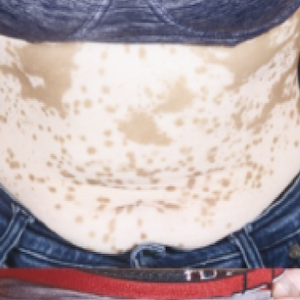Characteristics and decreased Vitiligo Area Scoring Index of vitiligo patients with narrowband-UVB phototherapy in Yogyakarta, Indonesia

Accepted: 23 April 2023
HTML: 2
All claims expressed in this article are solely those of the authors and do not necessarily represent those of their affiliated organizations, or those of the publisher, the editors and the reviewers. Any product that may be evaluated in this article or claim that may be made by its manufacturer is not guaranteed or endorsed by the publisher.
Narrowband ultraviolet-B (NB-UVB) phototherapy is the mainstay of vitiligo therapy. The response can be evaluated using the vitiligo area scoring index (VASI) and repigmentation grade. However, few studies used VASI to evaluate phototherapy response and there are no definitive data on the reduction of VASI. This retrospective descriptive study aimed to determine the characteristics and decrease of VASI in patients with vitiligo after 36 and 48 sessions of NB-UVB phototherapy, conducted at Dr. Sardjito General Hospital, Yogyakarta, from December 2021-June 2022. The most common predilection was on the face (71.43%) and acral (61.90%). The most common responses after 36 and 48 phototherapy sessions were minimally improved (decrease in VASI<10%) and improved (reduction in VASI 10-25%). The mean decrease in VASI was 18% and 22% after 36 and 48 phototherapy sessions, respectively. 9.52% and 6.67% of patients experienced a reduction in VASI >50% after 36 and 48 phototherapy sessions, respectively. VASI assessment can be used to evaluate the response to phototherapy in vitiligo. However, VASI cannot show a reduction in vitiligo with slight repigmentation in slow-response patients.
Ezzedine K, Harris JE. Vitiligo. In: Kang S, Amagai M, Bruckner AL, et al., eds. Fitzpatrick’s Dermatology in General Medicine. 9th ed. New York: McGraw-Hill Education; 2019. pp 1330–50.
Krüger C, Schallreuter KU. Report a review of the worldwide prevalence of vitiligo in children/adolescents and adults. Int J Dermatol. 2012;51:1206–12. DOI: https://doi.org/10.1111/j.1365-4632.2011.05377.x
Liu B, Sun Y, Song J, Wu Z. Home vs hospital narrowband UVB treatment by a hand-held unit for new-onset vitiligo: a pilot randomized controlled study. Photodermatol Photoimmunol Photomed. 2020;36:14–20. DOI: https://doi.org/10.1111/phpp.12495
Hamzavi I, Jain H, McLean D, et al. Parametric modeling of narrowband UV-B phototherapy for vitiligo using a novel quantitative tool: the vitiligo area scoring index. Arch Dermatol. 2004;140:677–83. DOI: https://doi.org/10.1001/archderm.140.6.677
Mohammad TF, Al-jamal M, Hamzavi IH, et al. The Vitiligo working group recommendations for narrowband ultraviolet B light phototherapy treatment of vitiligo. J Am Acad Dermatol. 2017;76:878–88. DOI: https://doi.org/10.1016/j.jaad.2016.12.041
Iannella G, Greco A, Didona D, et al. Vitiligo: pathogenesis, clinical variants and treatment approaches. Autoimmun Rev. 2016;15:335–43. DOI: https://doi.org/10.1016/j.autrev.2015.12.006
Alikhan A, Felsten LM, Daly M, Petronic-rosic V. Vitiligo: a comprehensive overview Part I. Introduction, epidemiology, quality of life, diagnosis, differential diagnosis, associations, histopathology, etiology, and work-up. J Am Acad Dermatol. 2011;65:473–91. DOI: https://doi.org/10.1016/j.jaad.2010.11.061
Mahajan VK, Vashist S, Chauhan PS, et al. Clinico‑epidemiological profile of patients with vitiligo: a retrospective study from a tertiary care center of North India. Indian Dermatol Online J. 2019;10:38–44. DOI: https://doi.org/10.4103/idoj.IDOJ_124_18
Speeckaert R, Geel N Van. Distribution patterns in generalized vitiligo. J Eur Acad Dermatol Venereol. 2014;28:755–62. DOI: https://doi.org/10.1111/jdv.12171
Ezzedine K, Lim HW, Suzuki T, et al. Revised classification/nomenclature of vitiligo and related issues: the vitiligo global issues consensus conference. Pigment Cell Melanoma Res. 2011;25:E1–13. DOI: https://doi.org/10.1111/j.1755-148X.2012.00997.x
Dégboé B, Atadokpèdé F, Saka B, et al. Vitiligo on black skin: epidemiological and clinical aspects in dermatology, Cotonou (Benin). Int J Dermatol. 2017;56:92–6. DOI: https://doi.org/10.1111/ijd.13366
Gawkrodger DJ, Ormerod AD, Shaw L, et al. Guideline for the diagnosis and management of vitiligo. Br J Dermatol. 2008;159:1051–76. DOI: https://doi.org/10.1111/j.1365-2133.2008.08881.x
de Francesco V, Stinco G, Laspina S, et al. Immunohistochemical study before and after narrow band (311 nm) UVB treatment in vitiligo. Eur J Dermatol. 2008;18:292–6.
Feldman SR, Zanolli MD. Phototherapy treatment protocols. 3rd ed. USA: CRC Press; 2016.
Komen L, Grac V, Wolkerstorfer A, et al. Vitiligo area scoring index and vitiligo european task force assessment: reliable and responsive instruments to measure the degree of depigmentation in vitiligo. Br J Dermatol. 2015;172:437–43. DOI: https://doi.org/10.1111/bjd.13432
Sehrawat M, Arora TC, Chauhan A, et al. Correlation of vitamin D levels with pigmentation in vitiligo patients treated with NBUVB therapy. ISRN Dermatol. 2014;2014:1–6. DOI: https://doi.org/10.1155/2014/493213
Farag AGA, Hammam MA, Al–Sharaky DR, El-Boghdady GM. Leucine-rich glioma inactivated 3: a novel keratinocyte-derived melanogenic cytokine in vitiligo patients. An Bras Dermatol. 2019;94:434–41. DOI: https://doi.org/10.1590/abd1806-4841.20198250
Bae JM, Jung HM, Hong BY, et al. Phototherapy for vitiligo: a systematic review and meta-analysis. JAMA Dermatol. 2017;153:666–74. DOI: https://doi.org/10.1001/jamadermatol.2017.0002
Brazzelli V, Antoninetti M, Palazzini S, et al. Critical evaluation of the variants influencing the clinical response of vitiligo: study of 60 cases treated with ultraviolet B narrow-band phototherapy. J Eur Acad Dermatol Venereol. 2007;21:1369–74. DOI: https://doi.org/10.1111/j.1468-3083.2007.02278.x
Kawakami T, Hashimoto T. Disease severity indexes and treatment evaluation criteria in vitiligo. Dermatol Res Pract. 2011;2011:4–6. DOI: https://doi.org/10.1155/2011/750342
Li R, Qiao M, Wang X, et al. Effect of narrow band ultraviolet B phototherapy as monotherapy or combination therapy for vitiligo: a meta-analysis. Photodermatol Photoimmunol Photomed. 2017;33:22–31. DOI: https://doi.org/10.1111/phpp.12277
Dong Y, Yang Q, Guo B, et al. The effects of tacrolimus plus phototherapy in the treatment of vitiligo: a meta-analysis. Arch Dermatol Res. 2021;313:461-71. DOI: https://doi.org/10.1007/s00403-020-02121-x
Batchelor JM, Thomas KS, Akram P, et al. Home-based narrowband UVB, topical corticosteroid or combination for children and adults with vitiligo: HI-Light Vitiligo three-arm RCT. Health Technol Assess. 2020;24:1-128. DOI: https://doi.org/10.3310/hta24640
Copyright (c) 2023 the Author(s)

This work is licensed under a Creative Commons Attribution-NonCommercial 4.0 International License.
PAGEPress has chosen to apply the Creative Commons Attribution NonCommercial 4.0 International License (CC BY-NC 4.0) to all manuscripts to be published.





 https://doi.org/10.4081/dr.2023.9708
https://doi.org/10.4081/dr.2023.9708



